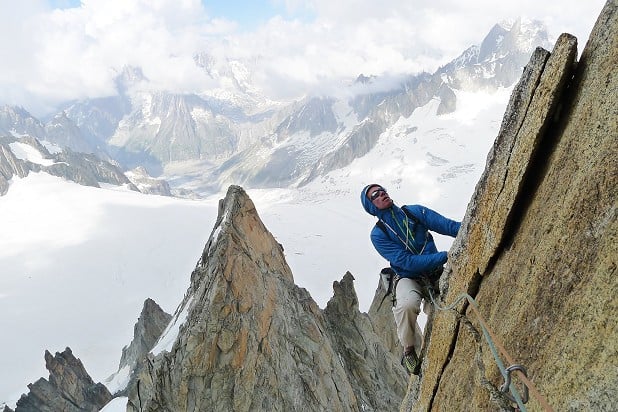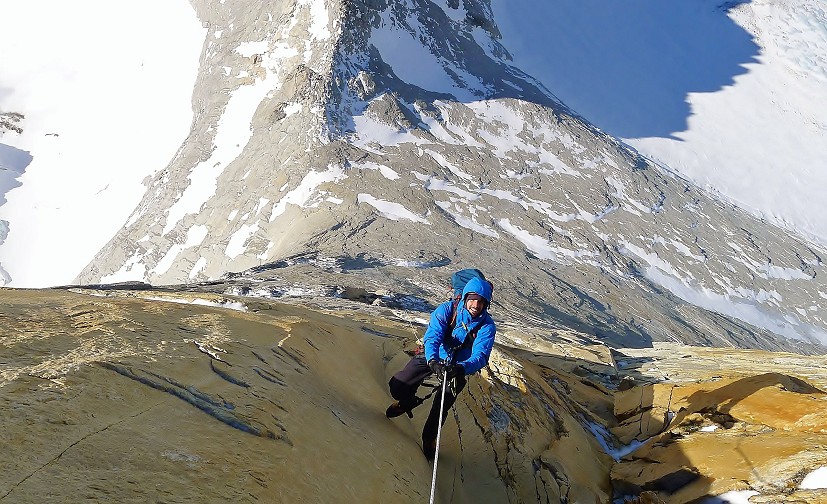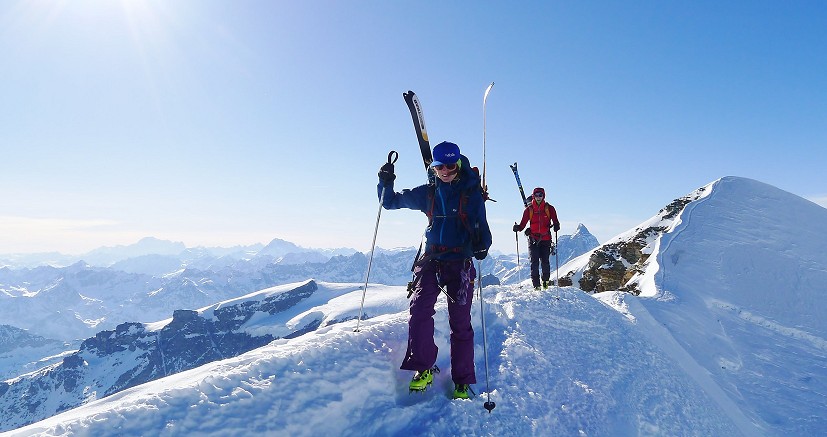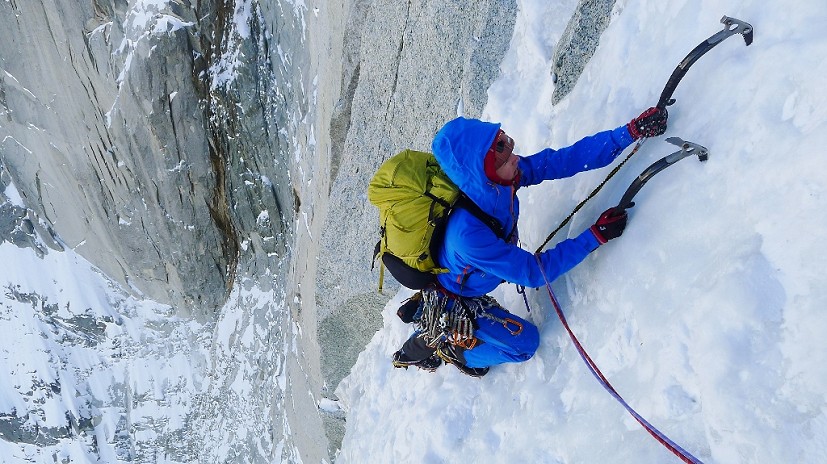High Altitude and Acclimatisation Part 4 - Training and Preparation for High-Altitude
In the final part of our four-part series on acclimatisation, Jamie Macdonald (high altitude physiologist at Bangor University) and Calum Muskett (professional climber and mountaineering instructor), return to the issue of fitness discussed in article one, and here provide some guidance on how to get yourself physically and mentally prepared for high-altitude mountaineering.
For many years, alpine mountaineering books and self-help manuals have concentrated on the hard-skills of mountaineering. The rope management, planning and safety elements that are crucial to achieving safe and efficient days out in the mountains. These 'hard-skills' are fundamental to safely enjoying time spent in the complex and often dangerous high mountain environment. What these books failed to capture was the holistic approach required to maximise performance and reduce risk. When preparing for our alpine or Himalayan objectives, goal-setting should be considered using the TTPP model to understand our strengths and weaknesses in the Technical, Tactical, Physiological and Psychological aspects.
Technical and Psychology
Whilst we hope this article series will help you understand where you are at with physiological preparation, the technical and psychological elements are no less important and often more nuanced. If you can, we recommend identifying these strengths and weaknesses with a climbing partner or coach.
When high altitude mountaineering, we should be operating within a high margin for error and this means practising skills in relatively safe and controlled areas such as climbing walls and sport climbing crags – an anathema to many alpinists. If you're tackling an ED rock or mixed route in the Alps you may come across climbing up to Scottish grade V or E1. If you find these grades simple and can climb them quickly at sea level, then your chances of success will be greatly increased and the time it takes for you to climb should be shorter and subsequently give you a shorter exposure to danger and fatigue. The knock-on effect of this approach is a positive experience which feeds greater confidence.
Whilst you can make quick improvements to your performance through physical training, psychological training is more nuanced and the gains are more slowly achieved. Many of us will have tried to overcome our (rather sensible) fear of falling at a climbing wall with fall practice – where you consciously let go of the holds in order to accustom yourself to the art of flight. Whilst this does, to a certain extent, make people feel more comfortable with falling, it often doesn't translate to climbing to absolute failure on an outdoor sport crag. Why? Because of the controlled environment of practise and the conscious decision to let go, rather than accepting the more difficult to achieve rational that your equipment is good, your fall zone is safe and you have a good belayer which means you can push on regardless of the level of control you'd like.
Whilst physical training can be fast tracked at the risk of over training and injury, psychological training requires volume and sustained exposure to risk. Whilst we'd like to believe Alex Honnold has freak genetics that have given him an underactive amygdala (emotional response processor in the brain), the more logical conclusion is that he has exposed himself to more technical soloing than anybody else and this has culminated in him pushing the standards of free soloing.
In plainer terms, our psychological capacity to deal with alpinism can be improved by reflecting on positive experiences. These positive experiences come from being well prepared physically, technically and tactically whilst pushing your alpine objectives in a progressive manner that is unlikely to produce 'epics'. Having a flexible approach, plan B's and slick ropework skills that can get you out of complex situations can change epic retreats into positive experiences where you have overcome adversity.
Different coping strategies can be applied, from breathing exercises to visualisation, but these are often difficult to apply 'in the moment' and come into play after an adverse experience where you have been experiencing your panic zone. A more effective approach is to beforehand remember the six P's: Prior Planning Prevents Piss Poor Performance.
Tactical
One of Britain's most renowned and successful high-altitude mountaineers is Mick Fowler, known for his careful preparation and tactics on Himalayan expeditions. Fowler's high success rate in the mountains can be partly attributed to his self-confessed "heavy and slow" tactics of alpine style mountaineering. Rather than trying to race up mountains with minimal food and equipment, Fowler and his climbing partners cover relatively small amounts of ground each day but with a consistency akin to an incoming tide. This approach helps avoid over-exertion, minimal daily height gains to aid acclimatisation, and includes a buffer zone of contingency time to account for bad weather days.
In stark contrast to Fowler, you had the swift ascents of the "Swiss machine" Ueli Steck. He would typically spend more time acclimatising and preparing before a rapid ascent of his set objective. A riskier strategy requiring a very high level of fitness and a smaller margin for error that for the majority of us is not achievable. With that in mind, these rapid alpine style ascents, waiting for the perfect conditions, weather and optimising on time, have certainly began to become popular in the European Alps where many teams are packing light and strapping themselves in to the killer faces. This can often lead to bigger successes and bigger failures.
These rapid ascents are the zone of 'facebook alpinism' that has become popular in recent years. Social media posts showing that the Jorasses, the Eiger or the Matterhorn are in condition produce a frenzied race to take advantage of the pristine conditions. In good conditions a one-day ascent of a climb as hallowed as the 1938 route on the north face of the Eiger is a reasonable proposition – but this should not be considered to be normal for that route and failure to succeed on a lightweight ascent leads to at best a cold bivi and at worst an embarrassing rescue, hypothermia or death.
Your tactics have to be right for the team and should always leave a margin for error. Careful planning taking into account glacial retreat, getting numerous topos to corroborate with each other and making sure that the conditions are right for the route create a blueprint for success. That is why alpinists like Mick Fowler and Paul Ramsden have climbed so many technical first ascents in the notoriously ephemeral conditions of the Himalaya. They have been self-sufficient, had the resources to adapt to unplanned additional nights on the mountain, made careful plans and used their prodigious skills in the mountain setting. Having a margin for error doesn't mean packing heavy bags for comfortable unplanned bivouacs, but it does require enough food, drink and warm gear to avoid you calling the air taxi.
Physiological
Climbing is often regarded as a lifestyle sport and lifestyle sports have, in the main, been slow to adapt to training programmes more normally associated with competitive sports. This can largely be attributed to the development of climbing as an 'extreme' sport, where psychological and technical elements had to be mastered due to the rudimentary safety net of traditional climbing equipment. Over the last forty years, as bouldering, sport climbing and climbing competitions have developed, so too has our understanding of specific physiological training. With ardent proponents of training over these decades from John Gill and Wolfgang Gullich to Alex Megos and Shauna Coxsey, it is now the 'new normal' to have a climbing coach or training programme where only ten years ago the idea was unusual.
Alpinism, however, still holds on to the romantic allure of a lifestyle sport. Perhaps this is because of the higher element of danger involved and the greater the technical demands and limitations of weather and altitude. It wasn't until 2014 that the first mainstream publication interrogating the world of physical training for alpinism was distributed with 'Training for the New Alpinism' by Steve House and Scott Johnston. The book describes, in some detail, how to physically train for alpine climbing covering general conditioning to preparing more specific training programmes. If you have objectives ranging from Mont Blanc to the Matterhorn or Denali to Everest, then this book is a veritable gold mine of advice.
If there are two salient points that we hope you can take away from this article series, then they are the advantages of taking your time to successfully acclimatise and being physically fit for your goals at altitude. Two simple, but often over-looked ideas. The first three articles have delved into how the body acclimatises, how to plan our trips to altitude and the advantages (or not) of aids to this process.
The leading cause of failure to summit (outside of weather and conditions in the mountains) is fatigue. Fatigue forces people to turn around, make easily avoided mistakes and if we're honest, we often scapegoat the weather, conditions or altitude for failure when the real cause could be lack of physical fitness. The same goes for trekking peaks. If you struggle to climb 1,500m of ascent at a low altitude, then doing this at a high altitude with boots and crampons strapped to your feet is going to hurt!
There are some basic principles we should adhere to when planning our training programmes:
Frequency
- Simply, how many times to train per week.
- Have you heard of the saying – "No pain no gain"? Or "Nothing in life is free"? Well, when it comes to exercise training, it is probably true. You need to exercise regularly to gain any benefit.
- For general health and wellbeing, the NHS guidelines are very helpful. If you are a bit baffled by all this talk of training principles, these guidelines may be a useful starting point to enhance physical activity and achieve your mountaineering goals.
- More specifically, if you goal is to be able to complete multiple back to back mountaineering days, you may wish to train using multiple back to back mountaineering days (e.g. two days over the weekend).
- Balance this "specificity" of training with what is safe for you. It may take a period of weeks of training with adequate recovery before you can complete back to back days…
Intensity
- Simply, how hard to train in each session.
- For general health and wellbeing, the NHS guidelines are very helpful. If you are a bit baffled by all this talk of training principles, these guidelines may be a useful starting point to enhance physical activity and achieve your mountaineering goals.
- More specifically, if your goal is to be able to walk at "moderate intensity" all day on an altitude trek, train at the same moderate intensity
- This is one principle where "more pain = more gain" may not be true – you do not need to run a marathon at Mo Farah speed in every training session to achieve this goal
- Balance this "specificity" of training with what is realistic for you. Be creative. For example:
- If life commitments prevent you from training at "moderate intensity" for 10 hour periods, you may need to increase intensity (i.e. train at "vigorous intensity" instead) to balance the decrease in time you can give to a training session (e.g. in a one hour slot over lunch time at work).
- To increase the efficiency of your training:
- Commercially available heart monitors are now good value, easy to use, comfortable to wear, and (at least for the reputable and more featured brands) include advice on training intensity (heart rate "zones")
- Even simpler, use a Rating of Perceived Exertion scale to control exercise intensity. This is a quantitative measure of perceived exertion during physical activity.
- You can use a Rating of Perceived Exertion scale to monitor and with practice control your exercise intensity, achieving similar training "zones" as a heart rate monitor
- The most theoretically valid scale is the Borg CR100 scale. Images of this are easy to find on the internet but the scale itself is protected by Copywrite. You can read about the scale's development here.
- Even simpler still, "moderate activity" will raise your heart rate, and make you breathe faster and feel warmer.
- One way to tell if you're working at a moderate level is if you can still talk, but you can't sing the words to a song.
- "Vigorous activity" makes you breathe hard and fast. If you're working at this level, you won't be able to say more than a few words without pausing for breath.
Time
- Simply, how long to train for in each session.
- Again, the "no pain no gain" saying applies here. You need to exercise for a sufficient amount of time in each session to gain any benefit.
- For general health and wellbeing, the NHS guidelines are very helpful. If you are a bit baffled by all this talk of training principles, these guidelines may be a useful starting point to enhance physical activity and achieve your mountaineering goals.
- More specifically, if your goal is to trek at altitude for 10 hours solid, build up to 10-hour training sessions.
- Balance this "specificity" of training with what is realistic for you. Be creative. For example:
- If life commitments prevent you from training for 10 hour periods, you may need to increase intensity (i.e. run) to balance the decrease in time you can give to a training session (e.g. in a one hour slot over lunch time at work).
- Balance this "specificity" of training with what is realistic for you. Be creative. For example:
- N.B. Very short duration, high intensity interval training (HIIT) has gained lots of press recently but evidence for benefits to altitude performance remain sparse.
- A minimum of 30 minutes per session is more likely to be beneficial.
Type
- Simply, what type of exercise will you do? I.e. run, cycle, walk and/or lift weights?
- For general health and wellbeing, the NHS guidelines are very helpful. If you are a bit baffled by all this talk of training principles, these guidelines may be a useful starting point to enhance physical activity and achieve your mountaineering goals.
- More specifically, if you are going to be climbing with a rucksack and heavy boots, train wearing a rucksack and heavy boots.
- Balance this "specificity" of training with what is realistic for you. Be creative. For example:
- If you can't wear your mountaineering boots to work, use some easily hidden ankle weights instead.
- Balance this "specificity" of training with what is realistic for you. Be creative. For example:
- Cross training remains a controversial but often necessary approach:
- Adding an active travel cycle or run commute may be different to your end goal but is still far better that doing no exercise as it will increase cardiovascular fitness.
- Similarly, swimming, treadmills, rowers etc again are better than nothing, and may allow additional training sessions that can enhance motivation and allow for recovery from more specific but fatiguing sessions (such as climbing wall sessions).
Safety and injury prevention
- Seek medical and/or fitness instructor advice if you have not exercised recently or have a medical reason or family history that exercise may exacerbate or cause harm.
- Warm up and cool down before and after each session.
- Progress: start slowly and build duration and then intensity as your body allows.
- Proprioception and strength training can prevent muscle strains, overuse injuries, and stabilise previous injuries, during training itself and specifically during mountaineering type activities (such as walking on uneven ground or carrying a heavy rucksack). Any good quality gym will have instructors and equipment to facilitate such specialised training.
Duration
- Don't leave it too late.
- It could take eight or more weeks to see a benefit of your training programme (we typically prescribe six-month programmes).
- Cramming in exercise just before departure will increase risk of injury during training and may enhance fatigue on the trip itself.
Summary
In this article series, we have tried to provide a scientifically justified but pragmatic approach to high altitude travel. We first explored the role of physical fitness on mountaineering success. In the second article we discussed the acclimatisation process and explored how we can best plan our trips to the high mountains in order to reap the rewards of successful acclimatisation. In the third we delved into the complex and controversial world of rapid acclimatisation to see whether 'quick fixes' can replace or assist the classical slow ascent acclimatisation profiles. In the final article we returned to the issue of fitness and provided some guidance on how to get yourself physically and mentally prepared for high-altitude mountaineering. Perhaps the key take-home message would be to step back and reflect on your build up plan to your mountaineering trip. Can you and your mountaineering partner(s) consider the issues discussed herein and change your build up plan or approach accordingly to allow you to be better prepared? At the very least, you might be more confident, enjoy your trip more, and at the very most, you will be safer and have an increased likelihood of success….. See you out there, Jamie and Calum.



